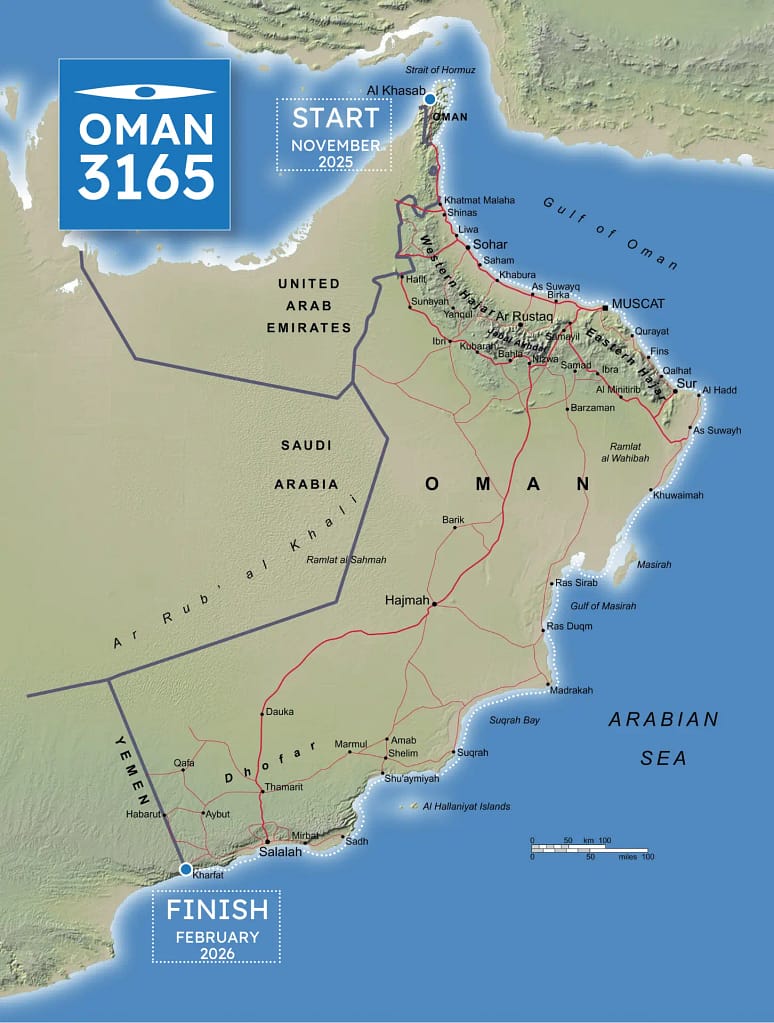Expedition
The Journey
The importance and health of our oceans for a sustainable future are increasingly in the spotlight; 2025 saw the third UN Oceans Conference in Nice, the theme of International Maritime Day has been ‘Our Ocean, Our Opportunity Our Obligation’ and 2026 will see the first COP dedicated to oceans. As a maritime nation The Sultanate of Oman is deeply connected to the sea, both historically and economically; its coastal waters abound with life, but like every ocean, that life is not as abundant as it once was.
Oman 3165 is a slow journey of celebration along the coastline of Oman in a 5-metre sea kayak. Starting in the north in Musandam, the journey will end some 70 days later in the small community of Dhalkut, on the border with Yemen. When the weather allows, the expedition will aim to cover some 30-40 km each day, coming ashore to camp on the beach each night before setting off an hour before sunrise each day.
Based on an Inuit design, the ocean-going kayak will be much more than a means of transport; using specially designed hydrophones and collecting samples and records for analysis by marine experts, it will be a floating laboratory.
Through podcasts, social media and using satellite communication technology the expedition will work with a wide range of leading international educational and scientific partners to engage with as many young people as possible and inspire a generation of planetary caretakers to ensure a sustainable future for our oceans.

The importance and health of our oceans for a sustainable future are increasingly in the spotlight; 2025 saw the third UN Oceans Conference in Nice, the theme of International Maritime Day has been ‘Our Ocean, Our Opportunity Our Obligation’ and 2026 will see the first COP dedicated to oceans. As a maritime nation The Sultanate of Oman is deeply connected to the sea, both historically and economically; its coastal waters abound with life, but like every ocean, that life is not as abundant as it once was.
Oman 3165 is a slow journey of celebration along the coastline of Oman in a 5-metre sea kayak. Starting in the north in Musandam, the journey will end some 70 days later in the small community of Dhalkut, on the border with Yemen. When the weather allows, the expedition will aim to cover some 30-40 km each day, coming ashore to camp on the beach each night before setting off an hour before sunrise each day.
Based on an Inuit design, the ocean-going kayak will be much more than a means of transport; using specially designed hydrophones and collecting samples and records for analysis by marine experts, it will be a floating laboratory.
Through podcasts, social media and using satellite communication technology the expedition will work with a wide range of leading international educational and scientific partners to engage with as many young people as possible and inspire a generation of planetary caretakers to ensure a sustainable future for our oceans.

The Kayak
The Kayak


Built by Valley Kayaks in Nottingham, the Nordkapp is the iconic, most influential sea kayak ever.
The Nordkapp celebrates 50 years of production in 2025. Inspired by the traditional Inuit kayak, it was specifically designed for a challenging expedition around the North Cape of Norway in 1975. The boat marked the beginning of modern sea kayak expeditioning, and was a watershed in sea kayak design. Since then it has been the boat of choice for serious sea kayakers around the world and has been paddled on many of history’s greatest sea kayaking expeditions, including journeys around Cape Horn, and circumnavigations of New Zealand, Japan, Australia and Great Britain.
The modern version of the Nordkapp is some 5.4 metres long. Unladen the boat weighs
25kg, but a series of bulkheads provide watertight internal storage space of 340 litres, meaning that paddlers can be on the water for day after day without the need for resupply.
The Godfather of Sea Kayaking

Alongside the modern-day Valley Nordkapp, on display at the launch of Oman 3165 was a near 100-year-old kayak made from sealskin and whalebone, a kayak that belonged to explorer, Gino Watkins.
Credited by experts in his field as being revolutionary for his period, Watkins worked with the Inuit and adopted their practices of dog sledding, Igloo building and hunting from kayaks. “These methods were typically overlooked in earlier British expeditions and even looked down on,” he says. At the time of his death at age 25, Gino Watkins had received the Polar Medal from the King as well as the Founders medal from the Royal Geographical Society, for the success of his work on the British Arctic Air Route Expedition (BAARE). The BAARE took place in 1930 and set out to pioneer an air route from England to America by mapping the East coast of Greenland and testing flying conditions over its hostile ice cap.
Gino became legendary at hunting from his kayak and the expedition is considered the birth of sea kayaking as a sport. In this section you’ll see the trailer for “Bridging the Ice,” a new documentary based on the life and work of British explorer Gino Watkins. Before his untimely death at age 25 in Greenland, the Royal Geographical Society believed him to be the natural successor to Sir Ernest Shackleton. To find out more about this remarkable man, visit https://www.bridgingtheicedoc.com Bridging The Ice courtesy of Nic Watkins

Alongside the modern-day Valley Nordkapp, on display at the launch of Oman 3165 was a near 100-year-old kayak made from sealskin and whalebone, a kayak that belonged to explorer, Gino Watkins.
Credited by experts in his field as being revolutionary for his period, Watkins worked with the Inuit and adopted their practices of dog sledding, Igloo building and hunting from kayaks. “These methods were typically overlooked in earlier British expeditions and even looked down on,” he says. At the time of his death at age 25, Gino Watkins had received the Polar Medal from the King as well as the Founders medal from the Royal Geographical Society, for the success of his work on the British Arctic Air Route Expedition (BAARE). The BAARE took place in 1930 and set out to pioneer an air route from England to America by mapping the East coast of Greenland and testing flying conditions over its hostile ice cap.
Gino became legendary at hunting from his kayak and the expedition is considered the birth of sea kayaking as a sport. Below you’ll see the trailer for “Bridging the Ice,” a new documentary based on the life and work of British explorer Gino Watkins. Before his untimely death at age 25 in Greenland, the Royal Geographical Society believed him to be the natural successor to Sir Ernest Shackleton. To find out more about this remarkable man, visit https://www.bridgingtheicedoc.com Bridging The Ice courtesy of Nic Watkins
The Team
Mark Evans
Expedition LeaderMark has lived in Arabia for more than 25 years, and is now based in Beauly, Scotland. In 2012 Mark was awarded the MBE by Her Majesty The Queen for his work using challenging outdoor journeys for personal development and learning, and In 2023 he was awarded the Medal of Honour by The Sultan of Oman for his work establishing Outward Bound in the Sultanate. In 2016 Mark travelled with two Omanis to become the first people in 85 years to retrace the first crossing of the largest sand desert on earth-the Rub Al Khali, a 49-day journey on foot and by camel from Salalah to Doha, and in 2025 he completed his latest expedition, a 30 day journey on foot, by camel and by 4x4 through the Sultanate of Oman following the 1928 route of explorer Betram Thomas.
Mohamed Al Zadjali
Expedition Team MemberMohamed is an outdoor educator and senior leader at Outward Bound Oman, an organization dedicated to personal development through challenging outdoor experiences. With a background in expedition leadership and youth development, he has led transformative journeys across Oman’s deserts, mountains, and coastline. Passionate about using nature as a classroom, Mohamed plays a key role in building local capacity and promoting environmental stewardship. His recent focus includes developing inclusive adventure programs and launching Oman’s first water-based training activities. The Oman 3165 journey aligns with his mission to reconnect people with nature and heritage through meaningful exploration.
Ana-Maria Pavalache
Expedition PhotographerCurrently based in the Swiss Alps, Ana-Maria is an outdoor photographer and International Mountain Leader who actively engages in social and environmental projects. Her passion for wilderness drives her to explore the world's most isolated communities, being involved in conservation initiatives. Whether it's trekking in Ladakh, exploring glaciers in the Karakoram range, and working with wildlife in Tajikistan, Ana immerses in nature to foster a deep understanding of our place in the world and explore the complexities of human experience through visual storytelling. Her latest project was the Jewel of Arabia Expedition, following the 1928 route of Bertram Thomas.
Saleh al Jabri
Expedition Team MemberSaleh served for 27 years as an officer in the Royal Navy of Oman. A real lover of the sea, Saleh grew up in a small fishing village named Haramel. One of the highlights of an incredibly adventurous life saw Saleh commanding the Jewel of Muscat, a 9th century sailing dhow through the silk route to from Oman to Singapore upon a Royal order from His late Majesty Sultan Qaboos Bin Said. Saleh received an Honorarium Medal in August 2010 awarded by His late Majesty Sultan Qaboos Bin Said for successfully completing the voyage. Saleh also served approximately 16 years on Shabab Oman, the Royal Navy of Oman three masted ship as a Training Officer, covering over 150,000 nautical miles and visiting approximately 45 countries around the world. Saleh was awarded a Medal of Excellence by His Late Majesty Sultan Qaboos Bin Said. His current role is as a Sailing Ambassador for Oman Sail, where he has several years of project management of various international events.
Nigel Harling
Expedition LogisticsNigel has a background in emergency planning, risk management and logistics and has a real passion for adventure and exploring remote and wild areas of the world. He has been a Police Officer for 30 years in Cumbria in the UK, where he also runs a sheep farm in the fells, and is heavily involved in Mountain Rescue. Nigel sits on regional and national boards with an expertise in Helicopter Rescue, and represents England and Wales at the International Commission for Alpine Rescue. He has led and participated on many youth and independent climbing and skiing expeditions to mountain and polar environments – including Svalbard, Greenland, Alaska, Yukon, Africa and the Himalaya. He has also sea Kayaked around Svalbard, and along the coast of Oman. Nigel founded and ran an aid charity bringing over 1000 Ukrainian refugees back to the UK, and taking aid to the East; this has now turned into a pizza company in Ukraine that has served over 1.5 million pizzas to displaced refugees in 2 years!
Alan Morrissey
Expedition LogisticsAlan Morrissey initially visited Saudi Arabia for a three-month project in 1997 and quickly fell in love with the Kingdom's vast and varied desert landscapes. Alan made his home in the Riyadh capital, where he has now lived for nearly 30 years. Alan is an experienced desert traveller, planning and leading trips throughout the country, and the wider Gulf, whilst always keeping a curious eye out for its diverse heritage, geology, flora, and fauna enroute. Alan has traversed the sands of the Empty Quarter multiple times - including leading a 2024 crossing by an adventure team of mountain bikers over 1,700km. An appreciation of Saudi Arabia's deep history has meant that Alan has visited a large number of its antiquities - hundreds of petroglyph sites and ancient stone-structures often situated in the Kingdom's furthest, most remote corners. Alan has supported numerous trips by local and international professional archaeologists, as well as award-winning travel authors. Alan's latest 2025 expedition has been in navigational and logistical support to the first north-south traverse of Saudi Arabia on foot with camels over a 4-month duration by BBC presenter, author, and adventurer Alice Morrison.
Tim Stott
Expedition LogisticsTim is an Emeritus Professor in physical Geography and Outdoor Education at Liverpool John Moores University where he led and taught on the BSc (Hons) Outdoor and Environmental Education for 27 years. His research on glacier hydrology and geomorphology has taken him to many parts of the world including Svalbard, Greenland, the Canadian Rockies, Bolivia and Peru in the Andes, Elbrus, Nepal and China in the Himalayas, the European Alps and Antarctica. He has published around 150 journal articles and several text books. Tim has been Chief Scientist and Chief Mountaineer on five British Exploring Society expeditions, and holds the Summer and Winter Mountain Leader Awards, BASI and Scottish Snowsports Ski Teaching Awards, is a British Canoeing Paddlesports Coach, is a Bushcraft Survival and Wilderness Living Skills instructor, and holds the REC Expedition and Wilderness First Aid qualification (2025). He first visited Oman in 2011 and has visited six times since in connection with Outward Bound Oman. He now runs Snowdonia Outdoors providing off-grid woodland holiday accommodation, bushcraft courses and canoe journeys in North Wales.


